If he is not teaching or at his practice, he is busy trying to establish appropriate human thermal comfort conditions in different building environments.
There is something about academics, especially seasoned academics. They belong to a different realm. Majority are humble, down to earth and gentle, yet confident and articulate. The award winning Green Architect Musau Kimeu is no exception. He is particularly interested in addressing environmental issues in architecture and when he is not teaching or at his practice, you will find him with his thermal data loggers and other scientific equipment trying to establish appropriate human thermal comfort conditions in different building environments.
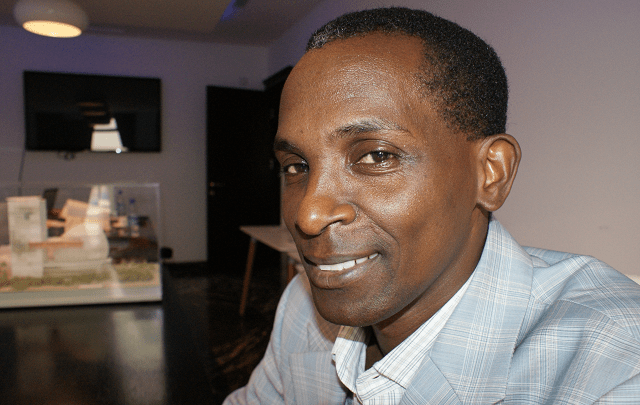
Arch. Musau Kimeu
With over 21 years experience as a practicing architect and 15 years of teaching at the university, Architect Musau Kimeu is well trained and exposed both locally and internationally. But how did Musau trace his path into academia and particularly green architecture? The son of a Baptist Church Pastor, Musau grew up near Machakos town, with his ancestral home bordering the banks of Ikiwe River at the foot of the imposing Kiima Kimwe hill. From his father’s compound, he would wake up every day facing the rolling hills of Kiima Kimwe and Iveti towards the North, Kalama and Mbooni hills to the East and the Kapiti plains towards the setting sun. This scenic setting would inspire the young Musau to love the environment. Building house models of sand and smooth riverbed rocks whenever he was at the river was a leisure pursuit as he played with other children. The lush vegetation along the river was a constant reminder of the importance of conservation and its meandering effect at the bottom of a deep valley, the rolling hills, the plains, natural vegetation and terraced farms embedded in his mind. This natural fascination would later steer his interest towards environmental design, creating built environments that are in ecological and aesthetic harmony with their surroundings. In addition, Musau’s learning in a technical school and his penchant for physics and mathematics was pivotal towards his choice for environmental design in Architecture.
Education
Musau attended the nearest local primary school, about an hour’s walk from his home. His mother challenged him to work hard to join Alliance High school and hopefully qualify for either the University of Cambridge or Oxford in England. When he sat for the Certificate of Primary Education (CPE) examination, Musau emerged the top candidate, a position he had held since joining the school. He then opted to join Machakos Technical School, now Machakos University College, and the nearest national school to his home for his Ordinary level of education.
It is while at Machakos Technical that he was exposed to various technical subjects that prepared him for a course in Architecture. These included Technical drawing, Wood and Metalwork, Electrical, Automotive and Mechanical engineering. His artistic skills were particularly sharpened by technical drawing. He emerged the top Kenya Certificate of Education (KCE) candidate too at Machakos Technical School and went to join Alliance high school for his A-levels.
In 1988, he joined the University of Nairobi for his undergraduate studies and graduated at the top of his Bachelor of Architecture class with First class honors. In 1999, Musau won two full scholarships to the University of Cambridge in England to pursue Master of Philosophy in Environmental design in Architecture.
Practice
Upon his return to Nairobi from Cambridge, Musau made up his mind to join a local architectural practice and at the same time, the teaching faculty in his former department of Architecture, University of Nairobi.
As he contemplated where to start, TRIAD Architects gave him a call, which turned out to be a job offer. Within the same week, Professor Anyamba, the then Chairman of the Department of Architecture, University of Nairobi gave him a call too to join the teaching faculty in the Department. He took up both jobs and commenced working in mid February 2001. His first project at TRIAD was the design and supervision of Communications Commission of Kenya (CCK) headquarters, along Waiyaki Way in Kabete, Nairobi.
It is in that project that he designed the first bull-nose shaped roof gutter in Kenya, which has become so fashionable in Nairobi that most architects use it in their buildings. From a cross sectional profile, the bull-nose shaped gutter flares upwards away from the building wall. Prior to his studies at Cambridge, Musau had worked with Architerion Architects where amongst his notable projects include The Premier Academy green roofed primary school block along Forest road, Nairobi and the Casablanca gated Community housing along Dennis Pritt road near State house, Nairobi.
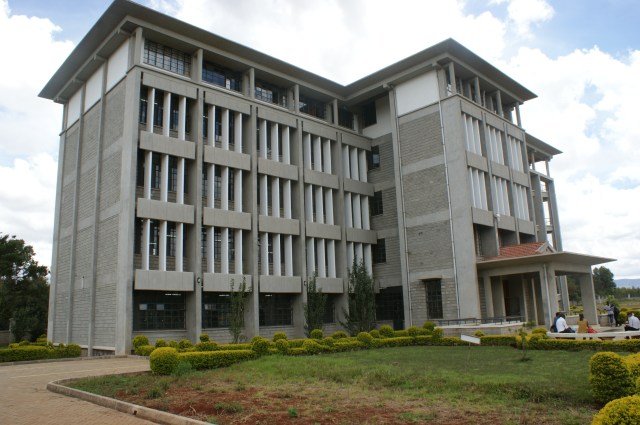
A Classroom Block at CUEA Upper Campus
In 2005, Musau founded his architectural practice Musau Kimeu, Architect. The practice has an apprenticeship program for students. Quality of what they design and build is their driving force. Some of their projects include a new classroom block at the Catholic University of Eastern Africa (CUEA) Upper Campus and The LRC also at CUEA.
Achievements/Awards
The environmental design expert who has remarkably contributed to the shape of architecture in Kenya, both in academia and practice by leading from the front, is a firm believer that an architect must always design for the user of the building and not to please himself with senseless hot buildings especially in our hot tropical climates.
In 2015, Musau won the Kenya Green Architect of the Year 2015 award, by the Kenya Energy Management Awards and his project, The LRC at The Catholic University of Eastern Africa won the Green Building of the Year award in 2014.
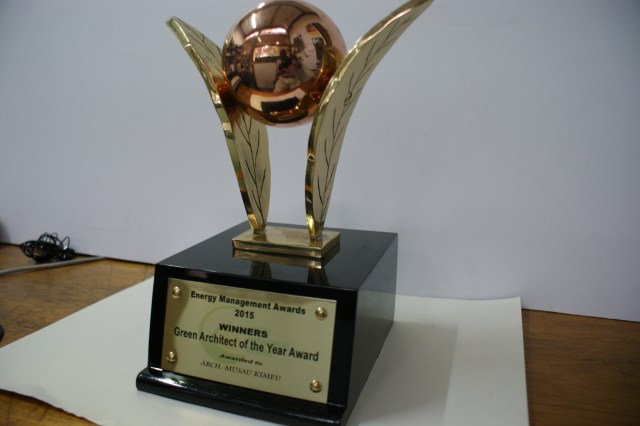
Musau’s Green Architect Award of the year
When Musau joined the Department of Architecture and Building Science, University of Nairobi, he established a Mentorship Program for all students whom he has had the opportunity to supervise. Through this program, most of them have over the years secured full scholarships to undertake Masters and PhD studies at the University of Cambridge, UK, in several other universities in Europe and also at the University of Nairobi. Almost every year Musau has at least one student proceeding for postgraduate studies in Environmental Design in Architecture at the University of Cambridge, UK.
Over the years, the performance of the department of Architecture and Building Science graduating class has been excellent, producing three valedictorians (the best graduating students) in the entire university in last ten years, specifically in 2006, 2010 and in 2015, all tutored by Mwalimu Musau as he is fondly referred by his students. Through his Mentorship program, many of his former students are now globetrotters, academics and practitioners in their own right. As a result, Kenya has the highest number of trained personnel in Green architecture in Africa. Musau has vast experience in judging both local and International architectural competitions. He was recently recognised by His Royal Highness Prince Mohammed AlFaisal of Saudi Arabia by having him as part of the jury for the International architectural design competition of the Faisal Islamic bank headquarters and Cultural centre in Khartoum, Sudan. Other International Design Competitions where Musau has been a Judge include the Wangari Maathai Institute for Peace and Environmental Studies’ Green campus at the University of Nairobi and the University of Nairobi Towers amongst many others. He is currently an External Examiner at the Department of Architecture, Jomo Kenyatta University of Agriculture and Technology. Musau is also the Chairman of the Department of Architecture and Building Science, University of Nairobi and the Chairman of the Environmental Design Consultants Chapter of the Architectural Association of Kenya (AAK).
Green/Sustainable Architecture
Architect Musau has this to say: “The quest for good quality living environments, for a harmonious balance between man and his locale is not new and thus, for centuries, mankind adopted this approach out of necessity, particularly in vernacular architecture. However, since the beginning of the industrial revolution in Europe around 1750 A.D., this has been increasingly abandoned in favor of universal architecture, which in many parts of the world, Kenya included, has led to the construction of very uncomfortable buildings to live in such as energy intensive buildings.
These are buildings that use large amounts of electricity to achieve human thermal comfort conditions e.g. operating air-conditioning or electrical fans to achieve internal air movement, buildings that require artificial lighting during daytime etc, leading to high electricity bills.
On the other hand, green buildings are habitable naturally and are comfortable to live in with no mechanical cooling! Buildings that do not fit this description include the glass walled buildings every Kenyan is building today. The glass-cladded or walled building is said to be suitable for the temperate climate found in London, New York and Chicago not tropical climate cities such as Khartoum, Nairobi and Dubai amongst others.
In Africa and the Middle East with their extremes of hot climate and Africa’s scarcity of resources, the glass walled building is unthinkably replicated. A close examination of these glass buildings indicates that today they are proving to be uneconomical, even in Europe not to mention that the cooling loads they generate in the tropics are ridiculously wasteful. Even old buildings that were originally suitably designed for the local climates, whenever they are being renovated, they are subjected to this glass cladding menace without questioning its hot tropical climates suitability. Examples in Nairobi include Victor house next to Nation Centre along Kimathi Street and Family bank headquarters at the corner of Jeevanjee Gardens and Muindi Mbingu Street. The glass walled building heats up quickly making its interiors a hot glass furnace, which is practically non-habitable in tropical climates without air-conditioning.
Fellow professional colleagues, why are we building these structures? The process of tactfully re-educating professionals, developers and building users not to expect sleek, glass sealed towers is an urgent necessity which architects and engineers have an important part to play. We must address the very concrete problem of why today’s cities are not comfortable to live in without use of artificial cooling systems. One of the essential factors is haste and of course lack of expertise. Today’s cities are built rapidly and in the process quality has disappeared. This is not only because technology permits it, but also because the boards of directors, architects and engineers, and the political systems are in a hurry!”
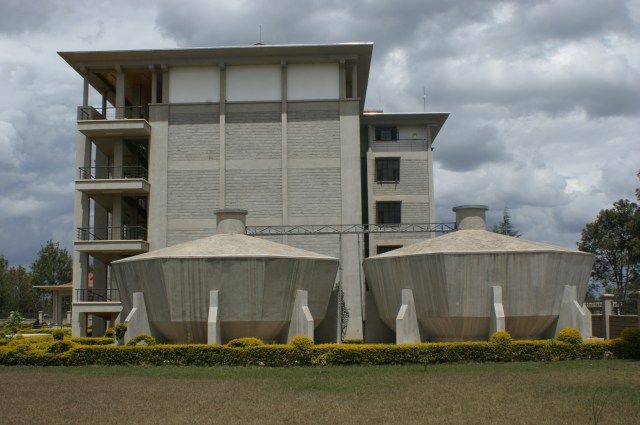
One of the few examples of a building in Kenya that meets the green building design strategies is the award winning Learning Resource Centre (LRC) at the Catholic University of Eastern Africa in Karen, Nairobi. A project by Architect Musau Kimeu, LRC at CUEA is an excellent illustration of green architecture and quality acoustics design. Its Library is naturally lit throughout daytime and its Conference hall naturally cooled using rocks arranged beneath its stepped seating, one of it’s kind in the world, instead of air-conditioning. It is from this Conference hall that President Uhuru Kenyatta gave his victory speech after winning the 2013 General elections. The project which was completed in 2012 consists of a 3000 seater ultra modern library, 1,200 seater state-of-the-art Conference facility and a 500 seater Cafeteria is a world class green project. It won the Green Building Award 2014 in Energy Management Awards (EMA) – a collaboration between the Government of Kenya, Kenya Association of Manufacturers and Global Environmental Facility. It is a forum where all stakeholders in the energy sector in Kenya converge to auspiciously celebrate excellence in energy management.
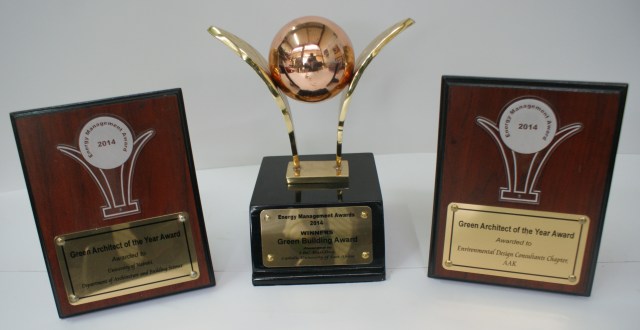
Some of the awards Arch. Musau has won over the years
The Safari Green Building Index
Musau’s research activities are centered on the environmental performance of buildings and are currently focused on Climate Change, passive and natural cooling strategies in Tropical Upland (Nairobi) and Warm-Humid (Coastal) climates, Swahili architecture, design with light and natural ventilation in libraries, acoustic design and natural ventilation in conference halls.
He has been researching extensively on Swahili architecture for the last fifteen years and today the Department of Architecture and Building Science, University of Nairobi is a Centre for Swahili architectural research. His deep appreciation of the undisturbed or natural environment, the tranquility of the natural ecosystems, the appreciation of biodiversity and always seeking a symbiosis between the natural and the man-made has made him to be a firm believer in touching the environment lightly with what he designs and build. That is his urge to fellow architects and designers.
One of the research activities he has been working on with a team of seven others is the development of a Green Building Rating Tool for East Africa named The Safari Green Building Index. He is the leader of the team which consists of Experts from the Environmental Design Chapter of The Architectural Association of Kenya (AAK), University of Nairobi and UNHabitat. It has taken the team slightly over three years to develop the tool. This will be released for public use soon.
The Safari Green Building Index is suitable for assessing all kinds of buildings in different climatic zones in Kenya and is also applicable in the other East African countries. It was developed from first principles and further fine-tuned by incorporating suggestions arrived at, following extensive review of six leading rating tools namely, LEED, BREAM, GRIHA, Green star, Green Mark and The Green Building Index. It takes into account the provisions of the Laws of Kenya including Environmental Management and Coordination Act (EMCA),
the Building Code and other local standards and laws.
The Safari Green Building Index is developed to assess projects in the built environment to establish their environmental performance and to provide leadership in sustainability through subsequent reduced energy loads and minimized ecological footprints and carbon emissions. It will fill the gap currently being experienced in the development of Sustainable or Green buildings in East Africa.
According to Architect Kimeu, the future of green architecture is bright, “I was among the first Kenyan Architects to undertaken postgraduate training in the specialized area of Environmental design in architecture and upon my return to Kenya in 2000, I set in motion an initiative to train others. I am happy to report that today Kenya has good number of trained personnel in green architecture. This team can now turn the tables and get people to change their attitudes and the environments we live in. Through the lectures I give in Eastern Africa, I have realized that many countries need professional help in their capacity building towards green architecture. Africa is looking up to us and as a country; we have a responsibility to offer leadership.”
Architect Kimeu has teamed up with UN-Habitat to offer part of the much-needed training in several African countries. He has been a role model, practicing his three-pronged model of: teaching/training, research and practice. Architect Kimeu would also like to see Kenya taking leadership position in steering the agenda for green architecture on the African continent. This will entail putting up buildings of cutting-edge status hence leading by example. “We have no choice but to take up leadership, this is where we belong, this is what the African continent is asking for. The team to design such buildings is actually in this country, the best of the best,” he insists. He concludes by saying, “One day I would like to say that I brought green architecture to a recognizable scale both in Kenya and at the global level and that there are buildings to attest to this. I do not want to be just a theoretician; I am both an academic and practitioner.”
- Log in to post comments

